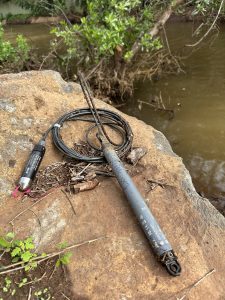Why Muliwai? The Science of Keeping Dirt off the Reef
In South Maui, erosion caused by habitat degradation, overgrazing, and wildfires makes it easy for mud to wash into gulches and ultimately, nearby coral reefs. The accumulation of dirt on the reef, or “sedimentation,” can kill corals by settling directly on them and smothering them. It can also cloud the water, effectively blocking the sunlight corals need for photosynthesis, which is the primary way corals produce their food.
Since November 2023, MNMRC has been studying several muiliwai along South Maui’s coast to understand better how much dirt is being washed into the ocean and which areas release the largest amounts of sediment into the water.
A muliwai, also called an estuary, is a place that connects and is in-between land and sea habitats. Here, freshwater and saltwater mix together, and in South Maui, they are also where many of the gulches, also known as intermittent streams, empty out during heavy rains. Since November, the water-level loggers MNMRC has deployed at three muliwai in South Maui have produced insights into the behaviors unique to each location.

Water-level loggers were deployed at 3 muliwai sites throughout South Maui. (Photo Credit: John Starmer)
“One of the things we are looking for at each muliwai is variability,” said John Starmer, MNMRC’s Chief Scientist. “Identifying the differences between muliwai and during different periods at the same muliwai gives us a better picture of how and how much mud is running off the mountain.” Stamer points to results from the Laie water-level loggers in January as an example. When heavy rains hit the island at the beginning of the year, the water in the muliwai was clear, indicating that the wetlands above it most likely absorbed and filtered out much of the sediment before it could reach the shore. But the next time heavy rains came, the water in the muliwai was brown, indicating that the wetlands had absorbed whatever sediment it could, but the rest ran down the mountain. Details like these are clues for Starmer and his team to figure out which areas in South Maui are priorities for preventing sediment from entering the ocean.
Additionally, Starmer has noticed that muliwai sometimes act as “ponding basins,” containing sediment during moderate rain events. “In some cases, the muliwai have shown that they can hold mud and sediment back, preventing it from washing into the nearby ocean,” said Starmer. “We saw this happen in November when rains hit the South side of Maui. Our direct observations and results from the water-level loggers showed the dune that seals off the muliwai was never breached meaning the runoff stayed in the muliwai and ultimately off the nearby reef.”
Studying the muliwai also helps MNMRC understand how well current prevention efforts work. “In theory, all of our mitigation efforts are making an impact but it is important to make sure we are measuring how much sediment is running off the mountain to have the data to ensure we are targeting the right areas and evaluate how well we are moving towards meeting our goals.”



No Comments
Sorry, the comment form is closed at this time.